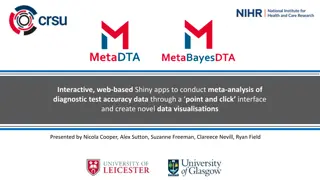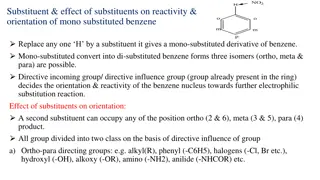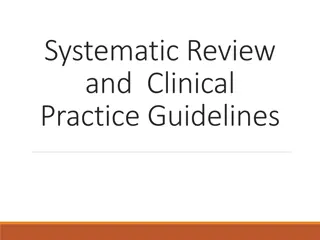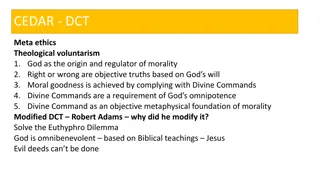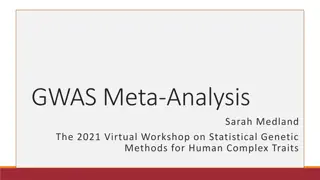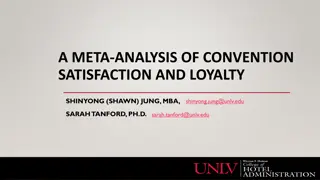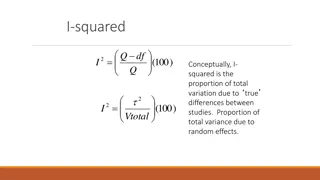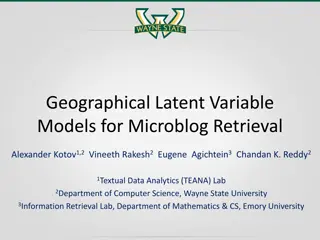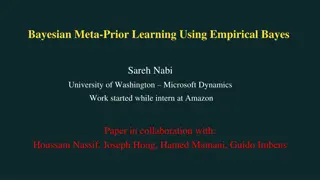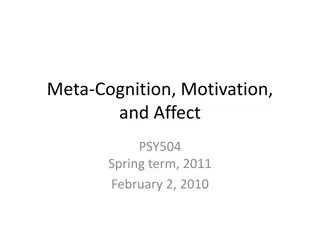Understanding Meta-Analysis: A Comprehensive Overview
Meta-analysis is a technique that combines results from various studies by converting them to a common measure, typically effect size. It faces challenges due to variations in population variability, selection of studies, and sensitivity of outcome measures. Factors like age, population characteristics, and study design influence effect size estimates in research. Feedback studies in STEM subjects involve a detailed classification based on the provider, delivery method, student's role, focus, type, presentation, referent, and frequency of feedback.
Download Presentation

Please find below an Image/Link to download the presentation.
The content on the website is provided AS IS for your information and personal use only. It may not be sold, licensed, or shared on other websites without obtaining consent from the author. Download presentation by click this link. If you encounter any issues during the download, it is possible that the publisher has removed the file from their server.
E N D
Presentation Transcript
Understanding meta-analysis: I think you ll find it s a bit more complicated than that (Goldacre, 2008) 1
Understanding meta-analysis 2 A technique for aggregating results from different studies by converting empirical results to a common measure (usually effect size) Standardized effect size is defined as: Problems with meta-analysis Variation in population variability Selection of studies Sensitivity of outcome measures ?
Annual growth in achievement, by age 4 1.6 A 50% increase in the rate of learning for six- year-olds is equivalent to an effect size of 0.76 1.4 annual growth (SDs) 1.2 A 50% increase in the rate of learning for 15- year-olds is equivalent to an effect size of 0.1 1.0 0.8 0.6 0.4 0.2 0.0 5 6 7 8 9 10 11 12 13 14 15 16 Age Bloom, Hill, Black, and Lipsey (2008) ?
Variation in variability 5 Studies with younger children will produce larger effect size estimates Studies with restricted populations (e.g., children with special needs, gifted students) will produce larger effect size estimates ?
Feedback in STEM subjects 7 Review of 9000 papers on feedback in mathematics, science and technology Only 238 papers retained Background papers Descriptive papers Qualitative papers Quantitative papers Mathematics Science Technology 24 79 24 111 60 35 16 Ruiz-Primo and Li (2013) ?
Classification of feedback studies 8 1. Who provided the feedback (teacher, peer, self, or technology-based)? 2. How was the feedback delivered (individual, small group, or whole class)? 3. What was the role of the student in the feedback (provider or receiver)? 4. What was the focus of the feedback (e.g., product, process, self- regulation for cognitive feedback; or goal orientation, self-efficacy for affective feedback) 5. On what was the feedback based (student product or process)? 6. What type of feedback was provided (evaluative, descriptive, or holistic)? 7. How was feedback provided or presented (written, video, oral, or video)? 8. What was the referent of feedback (self, others, or mastery criteria)? 9. How, and how often was feedback given in the study (one time or multiple times; with or without pedagogical use)? ?
Main findings 9 Characteristic of studies included Maths Science Feedback treatment is a single event lasting minutes 85% 72% Reliability of outcome measures 39% 63% Validity of outcome measures 24% 3% Dealing only or mainly with declarative knowledge 12% 36% Schematic knowledge (e.g., knowing why) 9% 0% Multiple feedback events in a week 14% 17% ?
Sensitivity of outcome measures 11 Distance of assessment from the curriculum Immediate e.g., science journals, notebooks, and classroom tests Close e.g., where an immediate assessment asked about number of pendulum swings in 15 seconds, a close assessment asks about the time taken for 10 swings Proximal e.g., if an immediate assessment asked students to construct boats out of paper cups, the proximal assessment would ask for an explanation of what makes bottles float Distal e.g., where the assessment task is sampled from a different domain and where the problem, procedures, materials and measurement methods differed from those used in the original activities Remote standardized national achievement tests. Ruiz-Primo, Shavelson, Hamilton, and Klein (2002) ?
Impact of sensitivity to instruction 12 Effect size Close Proximal ?



